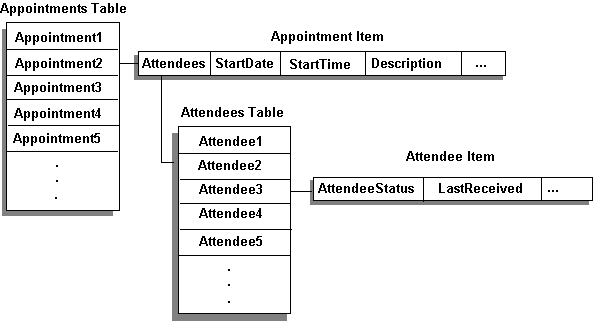
When creating a table with Visual Basic, reference the table or item within it as an instance of a specific object. This object is a representation of the abstract table or item type. For example, when creating an appointment, you create an instance of an Appointment object.
Schedule+ defines an Appointments table that contains all appointments within a userís schedule file. Each row of the Appointments table is an Appointment item that contains a set of properties you can get and set. Properties defined on an Appointment object include Start and OwnerName.
In some cases, a property itself can be a table. For example, an Appointment object might include the Attendees property, which returns a table that contains all the attendees for the appointment.
The following figure shows the Table object hierarchy for the preceding examples.

To support operations on tables, the Schedule+ Automation interface defines methods and data members common to all tables.
Instances of tables have the following data members.
| Data Member | Description |
|---|---|
| AccessPermitted | Returns access control information for items in a table. |
| Application | Returns an Application object. |
| ChangeNumber | Returns the current change number of the table. |
| Class | Returns the data type of the property. |
| IsEndOfTable | Returns whether the cursor position is at the end of the table. |
| Name | Returns the name of the table object. |
| Parent | Returns to an objectís parent. |
| Position | Returns the current cursor position in the table. |
| Rows | Returns the number of rows in the table. |
Instances of tables have the following methods.
| Method | Description |
|---|---|
| DeleteItem | Deletes an item from the table. |
| GetRows | Retrieves a two-dimensional array of properties where each row corresponds to an item and each column corresponds to the specified name or property identifier. |
| Item | Returns the Item object to which the cursor points. |
| New | Creates a new item in the table. |
| Reset | Sets the current item cursor to the top of the table. |
| SetChangeIndex | Positions the cursor so that the rows following the cursor have change indexes greater than the specified value. |
| SetRange | Restricts the table to a specified date range. |
| SetRestriction | Sets a restriction on a table. Does not work for merged tables. |
| Skip | Skips a specified number of rows forward or backward in the table. |